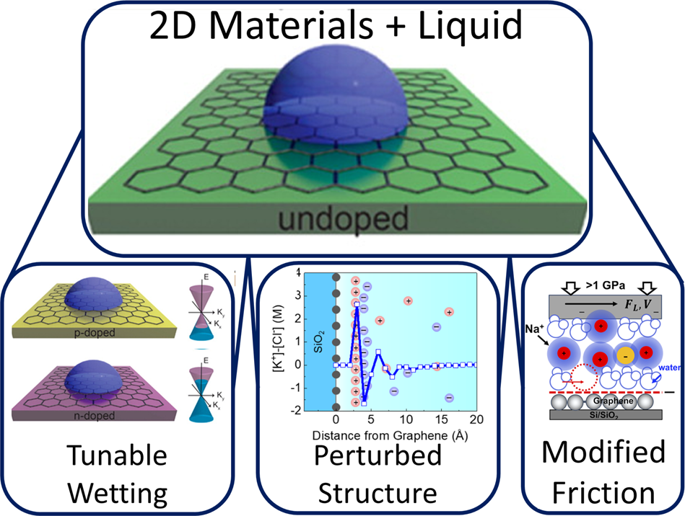NPG Asia Materials ( IF 8.6 ) Pub Date : 2020-03-13 , DOI: 10.1038/s41427-020-0203-1 Peter Snapp , Jin Myung Kim , Chullhee Cho , Juyoung Leem , Md Farhadul Haque , SungWoo Nam

|
The emergence of two-dimensional (2D) materials as functional surfaces for sensing, electronics, mechanics, and other myriad applications underscores the importance of understanding 2D material–liquid interactions. The thinness and environmental sensitivity of 2D materials induce novel surface forces that drive liquid interactions. This complexity makes fundamental 2D material–liquid interactions variable. In this review, we discuss the (1) wettability, (2) electrical double layer (EDL) structure, and (3) frictional interactions originating from 2D material–liquid interactions. While many 2D materials are inherently hydrophilic, their wettability is perturbed by their substrate and contaminants, which can shift the contact angle. This modulation of the wetting behavior enables templating, filtration, and actuation. Similarly, the inherent EDL at 2D material–liquid interfaces is easily perturbed. This EDL modulation partially explains the wettability modulation and enables distinctive electrofluidic systems, including supercapacitors, energy harvesters, microfluidic sensors, and nanojunction gating devices. Furthermore, nanoconfinement of liquid molecules at 2D material surfaces arising from a perturbed liquid structure results in distinctive hydrofrictional behavior, influencing the use of 2D materials in microchannels. We expect 2D material–liquid interactions to inform future fields of study, including modulation of the chemical reactivity of 2D materials via tuning 2D material–liquid interactions. Overall, 2D material–liquid interactions are a rich area for research that enables the unique tuning of surface properties, electrical and mechanical interactions, and chemistry.
中文翻译:

二维材料与液体的相互作用:润湿性,电化学性能,摩擦和出现的方向
二维(2D)材料作为传感,电子,机械和其他众多应用的功能性表面的出现,突显了理解2D材料与液体相互作用的重要性。2D材料的薄度和环境敏感性导致了驱动液体相互作用的新颖表面力。这种复杂性使基本的2D物料-液体相互作用可变。在本文中,我们讨论了(1)润湿性,(2)双电层(EDL)结构和(3)二维材料-液体相互作用产生的摩擦相互作用。尽管许多2D材料具有固有的亲水性,但它们的可湿性会受到其基材和污染物的干扰,这会改变接触角。润湿行为的这种调节使得能够进行模板,过滤和致动。同样,二维材料-液体界面处固有的EDL很容易受到干扰。此EDL调制部分解释了润湿性调制,并启用了独特的电流体系统,包括超级电容器,能量收集器,微流体传感器和纳米结浇口装置。此外,由扰动的液体结构引起的二维分子表面液体分子的纳米约束导致独特的水摩擦行为,影响了二维材料在微通道中的使用。我们希望2D物质-液体的相互作用能为将来的研究提供信息,包括通过调整2D物质-液体的相互作用来调节2D材料的化学反应性。总体而言,二维材料与液体之间的相互作用是一个值得研究的领域,可以对表面性质,电气和机械相互作用进行独特的调整,











































 京公网安备 11010802027423号
京公网安备 11010802027423号